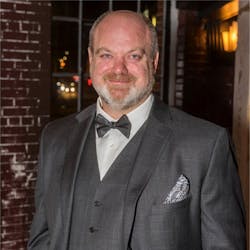OFCnet will once again highlight how network operators can look forward with their network during the OFC 2024 trade show.
The OFCnet network was built to showcase emerging technologies, including quantum networking, network element interoperability, SDN and programmability, and networking for big data/big science applications from industry innovators.
OFCnet enables booth-to-booth fiber connectivity for on-site optical demonstrations while extending CENIC to the OFC show floor. This connectivity provides new opportunities for exhibitors collaborating with affiliated academic institutions to highlight advancements and capabilities in a live, real-time, fully operational network environment.
The genesis of OFCnet began in 2022 through a partnership with CENIC (the Corporation for Education Network Initiatives in California) and Lumen. CENIC advances education and research statewide by providing a computing network essential for innovation, collaboration, and economic growth.
In 2022, Lumen laid the final network piece to OFCnet and brought dark fiber into the San Diego Convention Center.
Marc Lyonnais, director of external research at Ciena, Canada and chair of OFCnet, said that the goal is to change the experience attendees get when they attend OFC.
“We are trying to bring network discussion back to the exhibit floor,” he said. “It’s either you are selling optical components or transmission equipment, so we brought Optica where they want to expand the conversation on the floor.”
Like his work with the Supercomputing show, the plan was to bring a live network onto the show floor. As part of that plan presented to Optica, the first year was a pilot.
Lyonnais said that OFCnet will continue to evolve. “This year we called for demos, and next year will be even more grandiose,” he said.
Interconnecting new technologies
A big focus of the OFCnet at OFC 2024 is interconnecting new emerging technologies. This will include a production network that could help better understand what to do with a 400G or terabit pipe.
“The question is what the network discussions are happening at the technical podium where we can move away from the theory and more to the practice,” Lyonnais said. “OFCnet will include workshops and an overall networking theme that reflects the idea that a network is an ecosystem of hardware, software, technologies, people, and what you need to build networks.”
The goal is to bring it to the next level beyond listening to one vendor or provider’s perspective. “Instead of having a per corporation window of what you can do with their Lego blocks, I am putting them all together and I remove with Ciena hat and bring people from the industry to connect.”
He added that these network elements will enable the group to examine technologies and ideas still in development. “We need a production network and an emerging network with quantum technology, next-gen plugs and academic institutions researching AI or next-gen telemetry.”
Multiple network elements
As a live network operating at a trade show, OFCnet required large pipes from local service providers.
The organization has procured various fiber connections. CEnic, ESNet (internet 2), and Lumen sponsored three fiber pairs between the San Diego Center and the Aero Drive point of presence PoP.
“From this PoP, we can connect anywhere in the world through the research and education network,” Lyonnais said.
However, the difference with OFCnet is that it uses the internet version dedicated to research and education. “There’s the regular internet, and science-based internet can’t do e-mail or Facebook apps because it’s purely for science,” Lyonnais said. “That’s the internet we’re using.”
By using the R&E internet network, OFCnet and its participating partners can gain access to higher speeds and reach.
“It allows better speed and a much global approach to be the best collaborative medium when it comes to network research because that’s what those networks are for,” Lyonnais said.
Wide-ranging demos
During OFC, OFCnet will showcase a total of 19 demonstrations.
One key highlight of the demonstrations is that eight are based on emerging technologies like quantum networking.
“It’s not just quantum key distribution,” Lyonnais said. “There are some other elegant emerging technologies. It is refreshing because you get tired of looking at the paper and saying show me the real thing.”
The other 11 classic demonstrations will focus on other areas like emerging network elements for research and education, telemetry and data lakes.
“All of these will be featured inside OFCnet,” Lyonnais said. “In the technical boardroom, you hear about these things with a paper being published, which are more academic and very theoretical, but in this era of Chat GPT, a live demo has far more credibility than a paper.”
He added that participants are excited to show you the demo because there’s “nothing more that focuses people like a deadline called OFC, and everyone is focused on optimizing infrastructure that will reach out to Tokyo, the University of Bristol, University of Amsterdam, Chicago—all of that live connected to OFCnet in the San Diego Convention Center.”
OFCnet’s leaders are also keen to incorporate new elements from the feedback they get from participants.
One of the requests from participants in the 2023 OFCnet was to have a data lake.
A data lake is a centralized repository designed to store, process, and secure large amounts of structured, semi-structured, and unstructured data. It can store data in its native format and process any variety, ignoring size limits.
“This data lake would be used as an AI data lake optimized for networking learning,” Lyonnais said. “There’s a lot of AI data lakes available, and this one would be a multi-vendor one, so there’s a big vision for what OFCnet can be and serve the participants to achieve something beyond what they can do on the regular exhibit floor.”
Quantum is an eye-opener
One of the things that has emerged for OFCnet is the growing interest in quantum.
Driven by the government, energy, and transportation verticals, the global market for quantum computing hardware, according to a new report by Research and Markets, is projected to exceed $9.1 billion by 2028. These market segments will use quantum computing for various applications, including simulation, optimization, and sampling.
The research firm forecasts that managed Quantum Computing services will reach $328 million by 2028 with a 47.3% CAGR. Deployment, maintenance, and consulting are critical professional services in the quantum computing market.
“The OFCnet activity has been an eye-opener for the industry, especially post-COVID,” Lyonnais said. “No one in the industry expected to see so many quantum component companies, so I would like to say that OFCnet may be the place to be when you get out of stealth mode when you’re doing emerging technologies.”
Emerging company benefits
There are many benefits for up-and-coming companies that want to participate in OFCnet. It offers a low-cost capability and creates a kiosk that minimizes the marketing footprint and maximizes the product footprint.
OFCnet has its own NOC that provides a noise-controlled environment.
“We have a live network, some great networking companies, as well as academic and industry demonstrations,” Lyonnais said. “We’re showing how it can be done and have conversations, and it’s on the exhibit floor.”
For example, participants can take part in hands-on courses on network repair. “Many people know how to build a network, but not many know how to repair one,” Lyonnais said. “We have a course on investigating a fiber cut on a network that involves connecting to the network and testing equipment that shows results.”
In all, it takes 38 volunteers to make OFCnet happen. These volunteers are paid by the businesses they work for.
“This allows all vendors to hang their ego at the door and build a network for the greater good,” Lyonnais said. “We created a workshop to ask how OFCnet helps you shape the networking challenges of the future.”
Ultimately, after a design is completed, the next question is, what’s the consequence?
Lyonnais said that “seeing those demos is a window opening on the users and the use cases for which those high-end super networks are being built, and that community gets to appreciate the network consequence whether they are working for scientific research or networking users.”
For related articles, visit the Network Design Topic Center.
For more information on high-speed transmission systems and suppliers, visit the Lightwave Buyer’s Guide.
To stay abreast of fiber network deployments, subscribe to Lightwave’s Service Providers and Datacom/Data Center newsletters.


